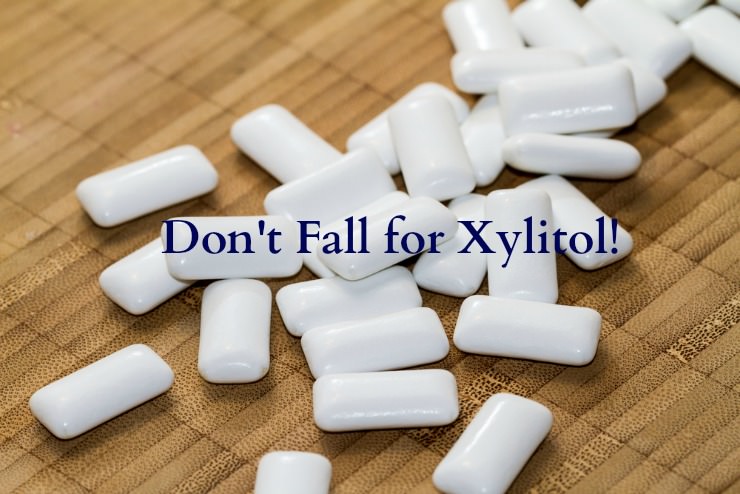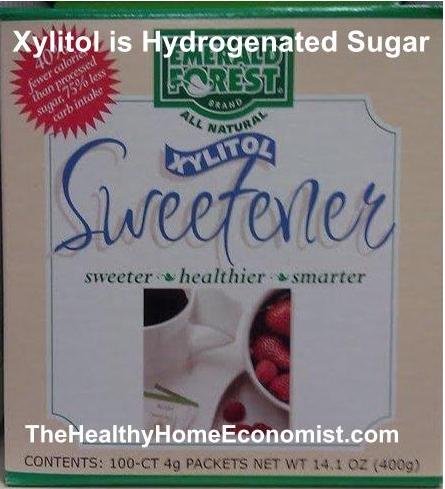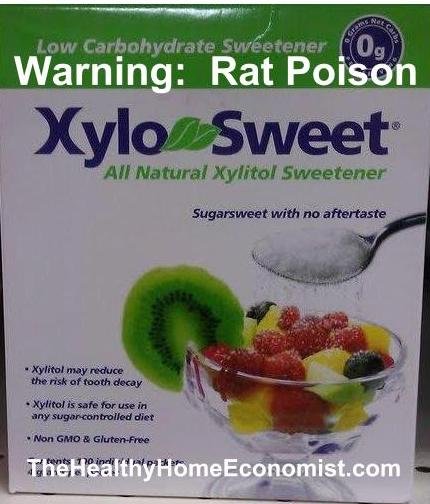
Xylitol is truly the darling of sugar substitutes today. The American Dietetic Association touts its use, with this sugar alcohol sold alone and as a sweetener in a variety of processed foods. Health benefits include a reduced glycemic response compared with sucrose, increased absorption of B vitamins and calcium, and even a reduction in dental caries risk.
Consequently, people with blood sugar issues are flocking to processed foods containing this alternative sweetener as a way to satisfy that sweet tooth without the downside of exacerbating the risk factors for Metabolic Syndrome. This condition is known for the markedly increased likelihood of developing heart disease, stroke, and type 2 diabetes.
Even the healthfood community almost universally considers this sugar alcohol to be a healthy substitute for sugar. A primary reason is that it doesn’t directly contribute toward the growth of intestinal yeasts aka Candida.
Have you noticed that the check out aisles at health food stores are typically loaded with chocolates and other sweets containing at least some xylitol? The truth is that I have yet to talk with any health-conscious person who suggests to me any downside other than the potential for intestinal cramps if you get too much.
Xylitol is Naturally Found in Nature
Xylitol is, after all, a naturally occurring substance. Manufacturers of xylitol market it as derived from xylan. The fibers of many plants contain it, including berries, oats, beets, sugar cane and birch. Sounds pretty harmless at first glance.
The FDA has even granted xylitol GRAS (Generally Recognized As Safe) status. You can’t get any safer than that, right?
 Manufacturing Process
Manufacturing Process
It is true that xylitol is a naturally occurring substance. However, manufactured xylitol is another matter entirely. Food manufacturers produce it using the industrialized process of sugar hydrogenation. In order to hydrogenate anything, a catalyst is needed. In this case, Raney nickel is used which is a powdered nickel-aluminum alloy. (1, 2)
This poses the risk of heavy metal residue and contamination. Nickel, by the way, is a recognized carcinogen and aluminum is associated with the development of dementia. Heavy metals in the body are notoriously difficult to eliminate with frequent use of infrared sauna probably a good idea.
This alternative sweetener doesn’t seem quite so warm and fuzzy anymore, does it?
There is currently no literature on any detrimental health effects of consuming hydrogenated sugar. However, food manufacturers widely used hydrogenated fats for decades before the very damaging effects of cardiovascular health became widely known!
Given the violent industrialized process that is required to produce a hydrogenated sugar like xylitol, it would seem wise to avoid it based on the very poor track record of hydrogenated foods in general.
Most Xylitol Sourced from GMO Corn
While it is true that xylitol can be derived from the xylan of birch trees, xylan is also found in corn cobs. It is much cheaper to use corn instead of birch bark to derive xylitol and so what do you think manufacturers prefer? Corn, of course.
Therefore, unless the label of a xylitol-containing product specifically notes that it is from birch or another nonGMO source, xylitol is very likely from genetically modified corn or possibly GMO sugar beets.
This is the same problem as high fructose corn syrup (HFCS) and white sugar from beets. Food manufacturers rely heavily on these sweeteners in the production of sodas and sports drinks.
You get a dose of GMOs with every sip! More on GMO dangers including sterility and stomach holes at the provided link.
Usage Contributes to Gut Imbalance
The digestive process does not break down sugar alcohols like food. Rather, xylitol arrives intact into the intestines.
At that point, a process called “passive diffusion” takes place. This means that the xylitol draws water into the bowels. Only a partial breakdown is the end result. The unmetabolized portion ferments providing the perfect environment for undesirable bacteria to thrive and grow.
It is true that xylitol itself does not feed candida directly as sugar does. As a result, this artificial sweetener is even promoted as a useful part of the Candida Diet. Unfortunately, the fermentation of undigested xylitol in the gut most definitely can exacerbate yeast problems. Don’t be fooled by this argument!
This is exactly why consuming xylitol can make some folks so gassy and even trigger cramping and diarrhea. Gut pathogens having a heyday in your intestines give off a lot of smelly toxins!
Other Little Known Problems
Xylitol can contribute to acid reflux problems. As a result, those who have issues in this area should avoid it for that reason alone. Chronic acid reflux is a serious problem that can lead to cancer of the esophagus and larynx.
In addition, those who suffer from seizures of any kind should stay away from this alternative sweetener as it can increase the frequency of epileptic attacks.
Two Pieces of Xylitol Gum Can Kill a Rat?
According to unpublished lab tests, approximately 1.65 grams of xylitol kills a 100-gram rat half the time.
Two little pieces of xylitol gum contain about .7 – 1 gram. This is probably enough to meet the definition of rat poison.

Cavity Prevention
Many people are chewing xylitol gum due to compelling scientific evidence for cavity prevention. What about children, however?
Rami Nagel, author of Cure Tooth Decay, doesn’t even recommend xylitol gum for this purpose. His research for any long term safety data turned up the following:
- Epidemiology: No information found
- Teratogenicity: No information found
- Reproductive Effects: No information found
- Mutagenicity: No information found
- Neurotoxicity: No information found
In summary, using this modern substance officially renders you a guinea pig, my friend! It seems that any benefits of cavity prevention are outweighed by the fact that there is no actual safety data backing up its use.
Safe Uses of Xylitol
Given all the problems that consumption of xylitol can trigger, it seems best to bypass the use of this sugar substitute on a regular basis.
Can it ever be helpful? Does it have any benefits whatsoever?
Potentially so. The only time I personally would ever consider using xylitol is to help resolve a childhood ear or sinus infection in order to prevent the use of drug-based antibiotics.
There is evidence that this popular sugar alcohol can indeed help encourage a healthy balance of beneficial bacteria found in the ear canal and sinus cavities. Products like this incorporate xylitol for this purpose.
A therapeutic dose can help resolve infection in these areas quickly with no medication required.
Thus, if you choose to use it, make sure it is sparingly and therapeutically (not as food). Also, make sure it does not come from a GMO source like corn!
References
(1) Xylitol production via catalytic hydrogenation of sugarcane
(2) Catalytic hydrogenation of xylose to xylitol using ruthenium catalyst on NiO modified TiO2 support
(3) Cure Tooth Decay by Rami Nagel
(4) Sugar-Free Blues: Everything You Wanted to Know about Artificial Sweeteners
More Information
Yacon: Healthy Syrup or Healthfood Hype?
Jaggery: India’s Sweet Gift








While I agree that any artificially derived substance should be studied extensively before being brought to market and the potential harmful effects noted, I do believe that your article is full of misinformation about the chemical processes which are used to create Xylitol. Though I admit I have not studied the actual processes used in manufacturing, I question your claims of “heavy metal residue”. First off, the definition of a “heavy metal” is often times misinterpreted and lacks a coherent scientific basis. Since you have seemed to classify Al and Ni as heavy metals, what would you say about our body’s physical requirements for other “heavy metals” such as iron, cobalt, copper, manganese, molybdenum and zinc? Just because something is classified as some way, doesn’t mean it is toxic, which is the tone you took in your article. In any case, these metals are a catalyst whose sole purpose is to speed up the reaction, and are necessary in the chemical world, from the processing of crude oil to the manufacturing of foods. They could just as easily use steel wool as a catalyst if it was efficient. The other point of contention which jumped out at me is your claim that all xylitol from GMO sources contains a “dose of GMO”. Xylitol is a chemical compound extracted from another source. It has a chemical formula of (CHOH)3(CH2OH)2, which would be the exact same if it was derived from a GMO source, a natural soure, or just simply finding another (likely expensive) method of combining carbons, hydrogens and oxygens in a certain way. There are no GMO genes in the forumla, no mutated DNA to impact our own, only a relatively simple chemical compound held together by chemical bonds.
I agree that Xylitol should be studied more, but trying to sway the argument against it using disinformation is an immoral tactic and is better suited for something like Fox News than a real discussion – you’re just trying to scare people by bending the truth.
Jan, you may love Sarah’s article, but the info is in error.
Use xylitol. It is indeed as sweet as it’s cracked up to be.
Hello SARAH!
Love your article.
Please tell me, what sweetener should I use then that is healthy or not toxic for human?
I don’t like stevia because it makes food taste different.
If not xylitol, what would you suggest? What to you use?
THANK YOU!
Why not put it in coffee and use it for baking? I think it makes perfect sense to use it both as a food and as an oral rinse. I do myself. And it is actually more effective and economical to use the granular form orally rather than gums or mints. The dentist Ulrich Bruhn who has researched it extensively, recommends using straight xylitol and has had great success with it. Please check out the article at healingteethnaturally.com, here is the link again:
This is a terribly misleading article. There are countless scientific studies that prove the benefits of xylitol. The rat example would be equivilant to me eating 2 pounds of xylitol. I’m sure I’d be sick after that! Who eats 2 lbs of sugar!? Also, naturally manufactured xylitol will work wonders. Stear clear of candy bars and baked goods that only “contain xylitol” becuase that usually means there is some other type of synthetic sugar that is no good.
Xylitol is fiber-like, yes. It’s processed by our bodies like a fiber so it brings water into your gut, but that doesn’t turn negative until you’ve had too much. The recommended amount per day is 5-6 grams for a human. That’s all you need.
So a guide to Xylitol:
1. make sure your source is pure, non-GMO and minimally processed
2. please don’t eat 2 pounds at once (stick to 5-6 grams per day)
3. for oral benefits don’t mix into coffee or pastries but rather take in the form of gum or mints
4. in order to see benefit it must be integrated into your daily routine
For oral benefits check out this website
http://drecoaching.com/
I order xylitol by the 5-lb. bag. I use it to sweeten tea, occasional sweet treats (made chocolate pudding with it, turned out great) and rinse with it for dental health. I think a lot of people are turned off by the name which seems to imply something fake and chemical, but as a few have pointed out here, it’s a natural substance found in fruits, birch bark, and produced by our own bodies. I wouldn’t advocate eating it a cup at a time, but who would anyway?
Even the argument against eating anything made from corn doesn’t stand up, where xylitol is concerned. Whether from birch or corn, it’s virtually identical.
I wrote a post at my own blog where I recommend it in the strongest terms:
http://writtens-jen.blogspot.com/2010/05/eating-cake-and-having-your-health-too.html
And some may find this info on its dental benefits quite eye-opening:
I appreciate your article, but I don’t think you back up your premise that most xylitol is made from GMO corn. If you really want to get that point across, I’d advise you not to use a picture of a xylitol product that specifically states it uses non-GMO corn.
Having said that, do you think Splenda is a better choice?
Thanks …
what about sugar made from pumpkin?